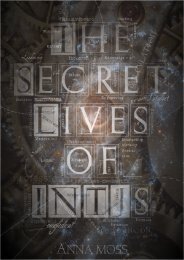You also want an ePaper? Increase the reach of your titles
YUMPU automatically turns print PDFs into web optimized ePapers that Google loves.
It is better to rely on information dealing with a famous person's daily habits, speech patterns, etc.<br />
rather than (say) major government policy decisions, job position held, etc. Dozens of un-type<br />
related factors go into the latter, but not the former; therefore daily habits are a better source for<br />
typing information than major decisions. I also recommend typing famous people using<br />
information about how they behaved before they became famous. These behaviors are more natural<br />
and less self-conscious.<br />
For this reason, the most useful sources of information are books that delve heavily into the nitty<br />
gritty of a celebrity's personal life. Books that merely report “dids” and “didn'ts” like, “Then he<br />
enacted this policy, then he traveled here, then he made this speech” are almost worthless for<br />
identifications—you can go for 100 pages without finding a single useful indication of a person's<br />
type. What you want are books that delve into the intimate details or character of the person,<br />
preferably with lots of anecdotes from the person's close friends, enemies, and acquaintances.<br />
Biographers seem to make a habit of describing a person's temperament for the first three chapters<br />
of the book, and then going into the dids and didn'ts for the next twenty chapters. For a quick<br />
identification, just the read the first fifty pages.<br />
One final caution is to avoid using the cognitive functions when making an identification. Besides<br />
the fact that there is no evidence for the functions' existence, there is also the fact that the<br />
definitions of Fe, Fi, Te, Ti, etc. are vague and tend to overlap each other to an unacceptable extent.<br />
I would not consider them a practical tool; rather, it is likely they will confound a correct analysis<br />
(See Appendix 1). 76<br />
Process<br />
When trying to identify a person you suspect is an INTJ, it often works best to first establish<br />
temperament, then introversion/extraversion, then finally judging/perceiving. You can work in any<br />
order, but this is the order in which the pieces often seem to fall into place.<br />
I find that the easiest thing to determine about a person is whether or not they are an NT. The<br />
Rational profile is highly characteristic, and an interest in math, science, or anything complex,<br />
abstruse and technical is almost always accurate in marking the temperament.<br />
The next easiest thing to establish is whether or not a person is an introvert or an extravert.<br />
Biographers are usually quick to say if a person is quiet and reserved. In fact, if a biographer fails<br />
to mention those characteristics, it is a pretty good bet that the person in question is an extravert,<br />
even if the biographer doesn't directly mention it. Extraversion is considered normal and hence not<br />
worthy of remark; introversion is considered atypical and worthy of note.<br />
Usually the most tricky part of an identification is determining whether an INT is a Judger or a<br />
Perceiver. Ironically enough, this would be one of the easiest things to figure out if you could meet<br />
the person face to face. But for whatever reason, biographers are not terribly interested in<br />
describing a person's J/P traits. When the traits are mentioned, they are often contradictory, with the<br />
word “orderly” (a J indicator) used in one sentence and the word “indecisive” (a P indicator) used in<br />
the next. Words describing J/P tend to have many possible interpretations depending on context.<br />
Interpret with caution.<br />
76 McPeek & Martin, 2012a; McPeek & Martin, 2012b




